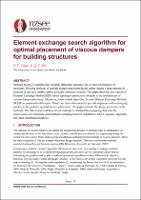| dc.contributor.author | Chan, Peng-Tai | |
| dc.contributor.author | Ma, Quincy | |
| dc.date.accessioned | 2020-06-18T13:44:17Z | |
| dc.date.available | 2020-06-18T13:44:17Z | |
| dc.date.issued | 2020-04-22 | |
| dc.identifier.uri | https://repo.nzsee.org.nz/xmlui/handle/nzsee/1715 | |
| dc.description.abstract | Optimal design of supplemental dampers efficiently enhances the seismic performance of structures. Existing methods of optimal damper placement design either require a large amount of iteration or can only reliably arrive at locally optimum solution. This paper describes the transfer of Element Exchange Method (EEM) from topology optimisation research to the optimisation of viscous damper placement. Moreover, a new search algorithm, Inverse Element Exchange Method (IEEM) is proposed in this paper. These two innovative methods provide engineers with converging quickly to the globally optimal damper placement. This paper presents the design procedure of the methods. The effectiveness of these novel methods is validated by comparing that with the effectiveness of commonly-used methods including uniform distribution, SSSA, Genetic Algorithm and other distribution methods. | |
| dc.language.iso | en | |
| dc.publisher | New Zealand Society for Earthquake Engineering | |
| dc.relation.ispartofseries | 2020;78 | |
| dc.subject | Seismic isolation, energy dissipation and vibration control of structures | |
| dc.title | Element exchange search algorithm for optimal placement of viscous dampers for building structures | |
| dc.type | Article | |

